One of the advantages of Google Analytics 4 is the automatic tracking of additional events besides the standard events that the program tracks (such as a page visit or a link click). With the help of this enhanced measurement, you can measure various interactions with the content on your website, including video engagement.
Setting up video engagement tracking
You can activate the measurement of video engagement under ‘Admin’ in your Google Analytics 4 property. In this panel, go to ‘Data Streams’ (in the ‘Property’ column) and select your data stream.

In the settings of your web stream data, click the checkbox to activate ‘Enhanced Measurement’, allowing Google Analytics 4 to measure interactions and content on your website. To check if video engagement is now being measured, click the gear icon and check if the checkbox for ‘Video engagement’ is activated. If not, it is important to enable it now.

If enhanced measurement was not previously activated, it may take approximately 24 hours for the data from these measurements to appear in the standard and custom reports.
Analyzing video engagement
By activating enhanced measurement for video engagement, you ensure that Google Analytics measures three events:
- video_start: when a video is played
- video_progress: when more than 10%, 25%, 50%, and 75% of the video is played
- video_complete: when the video is finished
To gain relevant insights into the engagement of website visitors with your video content, you can create a custom report (exploration) in Google Analytics 4 under ‘Explore’. To start creating your own report, click ‘Blank’.

Under ‘Variables’, you can name your exploration (for example, ‘Video engagement’) and choose the time frame for which you want to see the video engagement. Then add several dimensions to the report by clicking ‘+’. Here, select the dimensions ‘Event name’ (under the ‘Event’ tab) and ‘Video URL’ and ‘Video title’ (under the ‘Video’ tab) and then click ‘Import’ to add these dimensions to your report.
Additionally, under ‘Metrics’, you can add various metrics you want to analyze. In this example, we add ‘Number of events’ (under ‘Event’) and ‘Total users’ (under ‘User’).
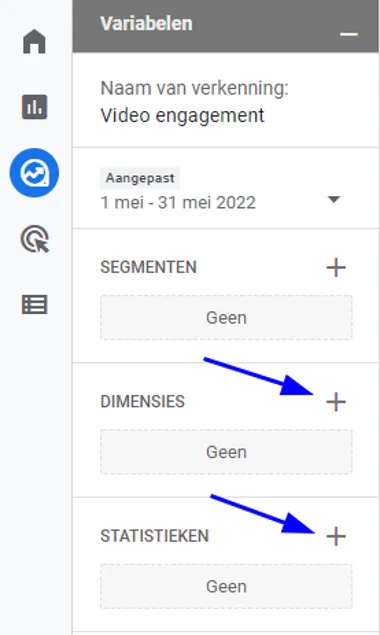
To see the titles of all videos with which your website visitors have interacted, double-click your dimension ‘Video title’. This dimension is now added as a row in your report. Then click both ‘Number of events’ and ‘Total users’ to add them as values in your report.
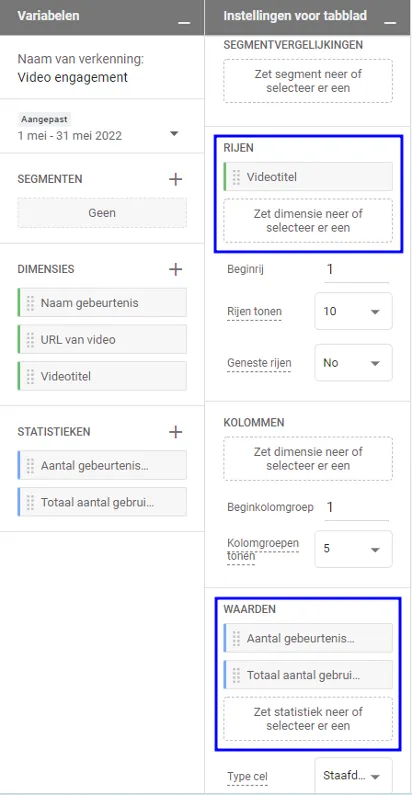
At this point, the report still includes all events, while we only want to see events where a website visitor (for example) starts a video. Therefore, you need to filter the report for all videos that have been started by visitors. Do this by clicking ‘Drop or select a dimension or metric’ in the ‘Filters’ section (in the ‘Tab settings’ column) and then choose ‘Event name’. In the field that appears, enter: Event name exactly matches video_start. Don’t forget to apply the filter.
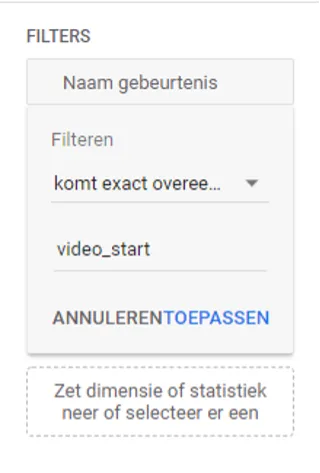
By following these steps, Google Analytics 4 generates a report of all video_start events, where you can see all videos that have been started by website visitors. Under ‘Number of events’, you see how often a particular video has been started, and under ‘Total users’, you find the number of website visitors who have started a particular video. This metric corrects for the fact that one visitor may have watched the same video multiple times.
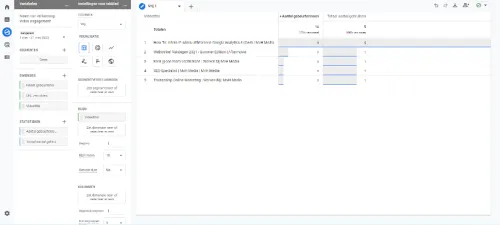
Furthermore, with the help of the video percentage, it is possible to analyze how far a visitor has watched a video. To create a report with these video percentages, it is necessary to create a custom dimension. Do this by going to ‘Custom definitions’ under ‘Configure’ and then to ‘Create custom dimensions’.

You can give the dimension a name of your choice (such as ‘Video percentage’), but always ensure that the scope is set to ‘Event’ and that the event parameter is exactly ‘video_percent’. Then save the custom dimension. Do this as soon as possible: data collected before the custom dimension was created will not be included in the report. Additionally, it may take up to 24 hours for your data to become visible. More about custom dimensions and how to use them can be found in this blog.
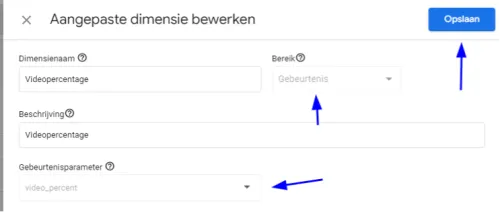
The next step is to create a new tab in your newly created report by clicking ‘+’.
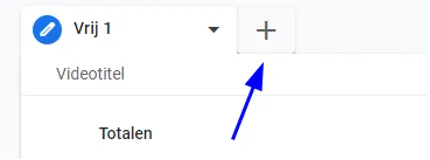
In this tab, you can add the dimension ‘Video percentage’ (found under ‘Custom’) to the report as a row in the same way you did with ‘Video title’ in the previous steps. As values, you again add ‘Number of events’ and ‘Total users’.
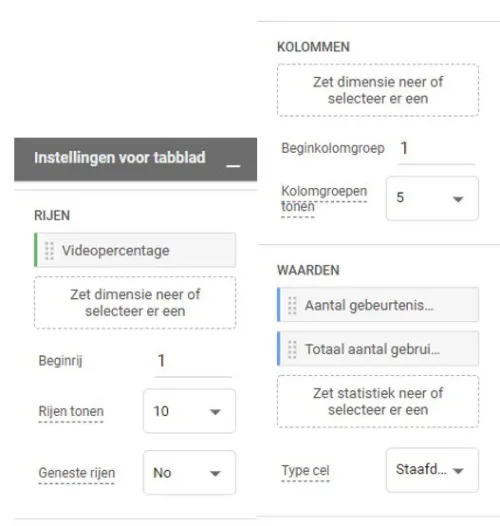
Then create two filters with the following conditions:
- Event name matches RegEx video_progress|video_start
- Video title contains [part of the name of the video you want to analyze engagement for]
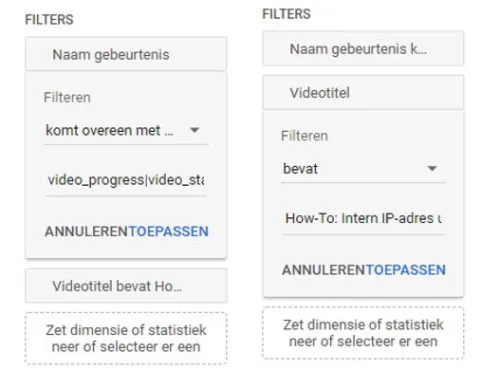
Then Google Analytics 4 generates a report for the different percentages of your chosen video.
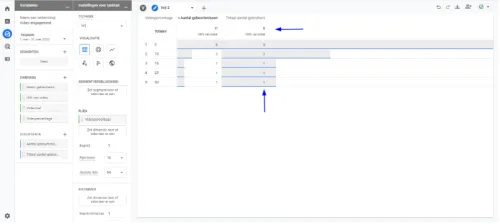
From the example above, you can deduce that five people have started this video, but only one person has watched more than half of the video. No one has watched this video completely.
In this example, there is also an event where 16% of the video is watched. This is caused by a visitor watching the video but not watching it completely. The YouTube player remembers up to where a visitor has watched the video. When they return to the page the next day and watch the video again, it plays from the point where they stopped (in this case, 16%). Google Analytics 4 then registers a new video_start, which now starts from 16% instead of the usual 0%. The 16% in this report is therefore actually a video_start event and not a video_progress event.
Congratulations! You have now created a report in which you can analyze the engagement of your website visitors with your video content. If you do not see any data in your report after following these steps, first check if there are events registered in Google Analytics 4 related to starting and watching your videos. If not, it may be that the automatic video tracking of Google Analytics 4 is not working on your website. In some cases, you may need to wait up to approximately 48 hours before your data appears correctly in the custom reports. Also, check if you have selected the correct date range and if all your dimensions, values, and filters are set correctly. If you are still having trouble or have questions about analyzing your videos or other events in Google Analytics, please contact the specialists at MvH Media!




